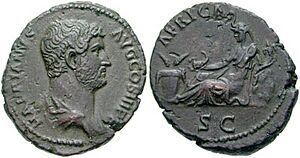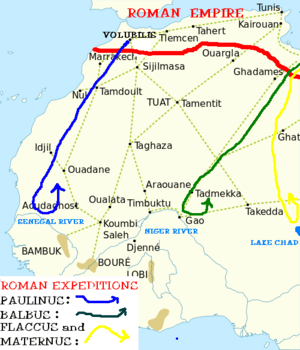Roman expeditions to Lake Chad and western Africa facts for kids

The Roman Empire was a powerful ancient civilization. Its people, the Romans, made many journeys into Africa. These trips were called Roman expeditions. They explored the vast Sahara Desert and reached places like Lake Chad and West Africa. These journeys happened between the first and fourth centuries AD. A main goal of these explorations was to find and bring back gold and valuable spices.
Contents
Exploring Africa: Roman Journeys
The Romans planned their trips across the huge Sahara desert. They used five main routes to explore different parts of Africa.
Routes Across the Desert
- One route went through the western Sahara. It led towards the Niger river, near where Timbuktu is today.
- Another path crossed the Tibesti mountains. This route headed towards Lake Chad and modern-day Nigeria.
- A third way followed the Nile river. This journey went south, reaching areas near present-day Uganda.
- Romans also explored the western coast of Africa. They sailed towards the Canary Islands and the Cape Verde islands.
- Finally, a route through the Red Sea led to modern Somalia. It might have even reached Tanzania.
Why the Romans Explored
Most of these expeditions were for trade. Roman soldiers often supported these journeys. They helped protect the traders. A key reason for exploring was to get gold. Camels were very important for carrying this gold across the desert.
Emperor Nero sent one special expedition. This trip in 62 AD seemed different. Two Roman soldiers explored the sources of the Nile river. This might have been to prepare for conquering Ethiopia or Nubia.
Roman ships also helped explore the African coasts. These sea journeys were important for trade. They connected the Roman Empire to the Indian Ocean.
History of Roman Expeditions
Many important Roman figures led these early explorations. They helped expand Roman knowledge of Africa.
Early Explorers
The first big Roman expedition was led by Lucius Cornelius Balbus. Emperor Augustus wanted to expand his empire. In 19 BC, Balbus conquered the Garamantes people in Libya. He then sent an explorer named Septimus Flaccus south. Flaccus crossed the Tibesti mountains and reached the Niger River.
Gaius Suetonius Paulinus led another trip in 41 AD. He explored what is now southern Morocco. He reached the northern part of the Senegal river. He likely also reached rivers that flow into the western Niger river. Suetonius Paullinus was the first Roman to lead an army across the Atlas Mountains. He crossed a desert of black sand and burnt rocks. He reached areas with elephants and snakes. Roman coins and other items found in Mauritania show trade happened there.
Julius Maternus was another Roman explorer. A few years earlier, he reached the Lake Chad area. He wrote about many animals there, like hippopotamus and rhinoceros. His journey lasted four months.
Exploring the Nile and East Africa
Emperor Nero also sent an expedition to Ethiopia. This trip aimed to find where the Nile River began. Around 62 AD, Nero sent soldiers to Meroe in Nubia. From there, they explored the Nile further south. Pliny the Elder wrote about another expedition in 68 AD. This was the first trip from Europe into equatorial Africa. It likely lasted several months. The explorers went around the Sudanese swamps. They reached the northern part of modern-day Uganda.
Exploring the West African Coast
After Rome conquered northern Morocco, they explored the western coast. King Juba II, a Roman ally, set up a successful trade route. Pliny the Elder wrote about a Roman expedition around 10 AD. This group visited the Canary Islands and Madeira Islands. They found old ruins but no people. They only found dogs, which is why the islands were called "Canary" (from the Latin word "canis" for dog).
Juba II also sent a naval force. They explored the Canary Islands, Madeira Islands, and probably the Cape Verde islands. They used Mogador (now Essaouira, Morocco) as their base. The Romans knew about the Cape Verde islands. They called them Gorgades. They knew they were two days' sail from the westernmost part of Africa.
Some ancient writings suggest Romans might have sailed even further south. They might have reached Guinea and the Gulf of Guinea. A Roman coin from Emperor Trajan was even found in Congo. This suggests very long-distance contact.
Controlling the Red Sea
Aelius Gallus led an expedition in 25 BCE. This trip crossed the Red Sea to Arabia Felix (modern Yemen). To control this area, Romans took control of both sides of the Bab-el-Mandeb strait. Cornelius Gallus set up a Roman outpost at Arsinoe in Eritrea. This was the only Roman base in eastern Africa south of Egypt. It lasted for several decades.
Sea Trade and Discoveries
Sea travel was very important for the Romans. They used ships to trade with distant lands.
Atlantic Coast Trade
Emperor Augustus wanted to sail all the way around Africa in 1 BC. The Romans had two naval bases on Africa's Atlantic coast. These were Sala near Rabat and Mogador in southern Morocco. The island of Mogador was important for making purple dye. This dye was highly valued in Rome. Augustus even planned an expedition to sail around Africa from Egypt to Mogador and Sala. This idea came from finding a sunken Roman ship near Djibouti.
Indian Ocean Trade
The eastern coast of Africa, south of Egypt, was a hub for sea trade. Romans traded a lot with India through the Somali coast. Roman books like "Periplus of the Erythraean Sea" list many market towns along this coast. Roman coins found along the coast confirm this trade. They even found coins in coastal Tanzania.
Ptolomey's "Geography" mentions a town called Rhapta. It was a "metropolis" (a main city) in a region called Azania, near modern Zanzibar. Archaeologists are still looking for Rhapta. They think it might be buried in the delta of the Rufiji River.
A scholar named Felix Chami found proof of Roman trade on Mafija island near Kenya. He also found evidence on the African mainland near the Rufiji River. This trade happened in the first few centuries AD. Roman coins have even been found in Zimbabwe and Madagascar. This suggests Roman ships might have sailed south of Azania. They might have reached areas with gold mines near the Zambesi river. They might have even reached the legendary Greater Zimbabwe kingdom.


